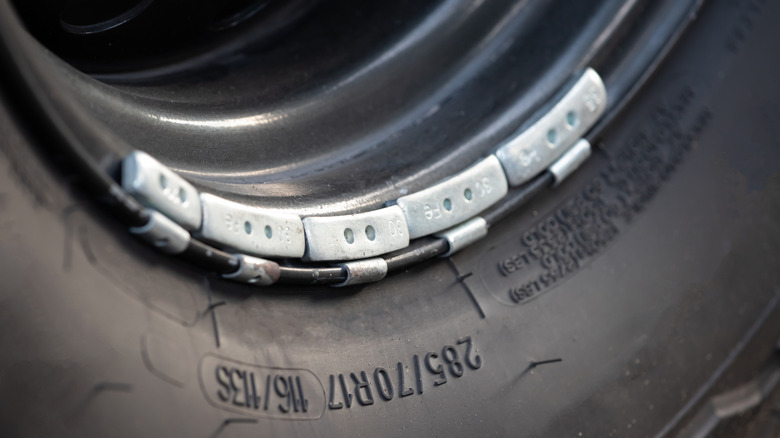What Do You Call The Little Squares On Wheels And What Are They For?
Your car wheels may seem relatively simple in their construction at first glance, but in truth they're surprisingly complex creations. Take the extra time to examine the wheels on your vehicle, and you're bound to find a few aspects that you may have not noticed, from various numbers to mechanical details. For instance, have you ever spotted little metal square or rectangular tabs fitted on your rims and wondered what they were for? As hard as it might be to imagine based on their unassuming nature, these attachments play a pivotal role in keeping your wheel stable and secure.
Known as wheel weights, these tabs are crucial in maintaining your wheel's balance. There are two common types of wheel weights. The first and most commonly used are clip-ons, which are made of metal and are attached to your rim's exterior edge. Adhesive wheel weights, which are constructed using lead and fitted behind the wheels, are more often used for heavier wheels such as those made of aluminum alloy.
During production, wheels will often have weight balance irregularities that manufacturers must take note of throughout the process. Wheel weights are then added to specific areas where such imbalances are noted. This protects the wheel itself from receiving extensive damage by ensuring even rotation and weight distribution. It also enhances performance and increases ride comfortability, preventing sudden shocks and bumps at higher speeds.
What kind of upkeep do wheel weights require?
Your wheels as a whole need regular maintenance to keep them looking fresh and staying at peak performance. It's easy to forget your wheel weights in this equation, assuming that they're too small to seriously worry about or durable enough to sustain hard knocks. But like every aspect of your wheel, it's best not to overestimate what these essential components are capable of if you want to ensure their longevity.
You may be surprised to learn that wheel weights becoming loose or coming off entirely is a relatively common problem. Damaged wheels or those that are aged are obvious culprits, but there are also more specific causes for this occurrence, such as adhesives failing to bond due to environmental reasons or the cleanliness of the surface. Using high-quality weights and keeping surfaces clean can go a long way in keeping weights strong and durable.
If you start noticing harsher vibrations and bumps while driving, then it may be a sign that your wheel weights are worn out and need to be replaced. Given the crucial role that these attachments play in your wheel's well-being, it's important that you don't attempt to perform a replacement on your own and instead bring it to an expert. Ensure that you know what kind of wheel weights your car uses and which are legal in your area, as lead adhesive weights are illegal in several states, including California, New York, and Washington. Additionally, make sure that the people tending to your tire aren't reusing weights, as these will wear out more quickly in most cases.

